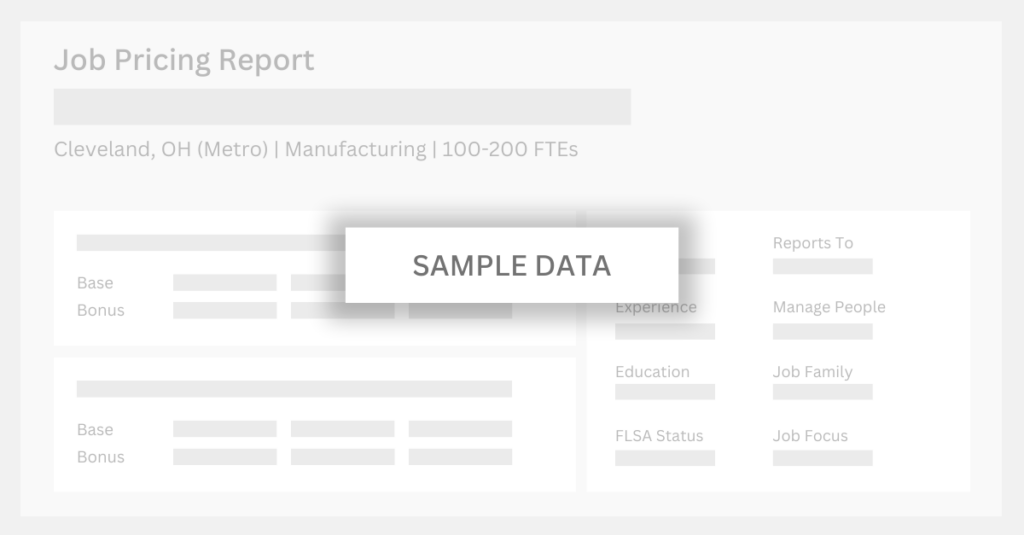Compensation Data for a Nursing Assistant in Ohio

Compensation data breakouts:
- Location (example: Cleveland, Akron, Ohio, National)
- Company Size (number of full-time employees)
- Industry (industry-specific or all industries)
- Years of Experience
- Education
Data included in each report:
- Base Compensation (Salary or Wage)
- Total Compensation
- Bonus
- Long-term Incentives
- Job Description
- Competencies/Skills
Get a Free Sample Report
Submit the form below to receive a sample job pricing report or to access ERC’s compensation data.

ERC is a leading provider of compensation data
Whether you’re actively recruiting and hiring or trying to stay competitive, having local salary and wage data is critical. ERC members gain access to compensation reports, job description research, and an HR Help Desk for compensation and workplace practices data.
Job Description
Overview
- Helps patients in hospital, nursing home, or other medical facility, performing a variety of uncomplicated tasks, under direction of nursing and medical staff.
- Responds to signal lights, bells, or intercom system to determine patients’ needs.
- Bathes, dresses, and undresses patients.
- Serves and collects food trays and feeds patients requiring help.
- Transports patients, using wheelchair or wheeled cart, or assists patients to walk.
Typical Functions
- Drapes patients for examinations and treatments, and remains with patients, performing such duties as holding instruments and adjusting lights.
- Turns and repositions bedfast patients, alone or with assistance, to prevent bedsores.
- Takes and records temperature, blood pressure, pulse and respiration rates, and food and fluid intake and output, as directed.
- Cleans, sterilizes, stores, prepares, and issues dressing packs, treatment trays, and other supplies.
- Gives medication as directed by Physician or Nurse and makes notation of amount and time given.
- Gives enemas, douches, massages, and alcohol rubs.
- Applies hot and cold compresses.
- Prepares food trays, feeds patients, and records food and liquid intake and output.
- May change bed linens, run errands, direct visitors, and answer telephone.
- May dust and clean patients’ rooms.
- May be assigned to specific area of hospital, nursing home, or medical facility.
- May assist nursing staff in care of geriatric patients.
- May assist in providing medical treatment and personal care to patients in private home settings.
Similar Positions
There are several positions that share similar responsibilities to a Nursing Assistant, including:
- Certified Nursing Assistant
- Patient Care Assistant
- Nurse’s Aide
- Health Care Assistant
- Personal Care Assistant
- Nursing Aide
- Home Health Aide
- Hospice Aide
- Rehabilitation Aide
- Geriatric Aide
Experience and Education
A Nursing Assistant typically requires a combination of education and practical experience in the field of healthcare. While formal education is not always mandatory, many Nursing Assistants complete a state-approved nursing assistant training program that includes classroom instruction and hands-on clinical training. This training equips them with the necessary knowledge and skills to provide basic patient care.
Additionally, Nursing Assistants often gain experience through internships, externships, or on-the-job training programs. They learn how to assist with activities of daily living, monitor vital signs, perform basic medical procedures, and maintain patient comfort and safety.
Strong communication, empathy, and interpersonal skills are essential for effectively interacting with patients and collaborating with healthcare professionals. Nursing Assistants should also have a solid understanding of infection control protocols, patient privacy laws, and ethical considerations in healthcare.
Competencies and Skills
- Patient care
- Communication
- Empathy and compassion
- Vital signs monitoring
- Infection control
- Basic medical procedures
- Safety awareness
- Flexibility and adaptability
- Documentation and recordkeeping
FAQ
A Nursing Assistant is typically not above a Nurse Practitioner in the professional hierarchy. Nursing Assistants provide basic patient care under the supervision of registered nurses or licensed practical nurses, assisting with daily activities and maintaining patient well-being. In contrast, Nurse Practitioners are advanced practice registered nurses with specialized education and training. They have a higher level of clinical expertise, diagnose and treat illnesses, prescribe medications, and provide comprehensive healthcare services. While both roles are important in the healthcare team, Nurse Practitioners have a greater scope of practice and autonomy in providing patient care.
Nursing Assistants are typically paid on an hourly basis rather than receiving a salary. Hourly wages for Nursing Assistants can vary depending on factors such as geographic location, experience level, and the specific healthcare setting in which they work. Hourly rates may also differ based on whether they work in a hospital, nursing home, home care, or other healthcare facility. Additionally, Nursing Assistants may be eligible for overtime pay for any hours worked beyond the standard full-time or part-time schedule. It’s important to note that wage structures and employment terms can vary, so it’s advisable to consult specific job postings or inquire with local healthcare employers to obtain accurate and up-to-date information regarding compensation for Nursing Assistant positions.
Through frequent polls and surveys, ERC offers a comprehensive collection of recent, reliable data covering workplace practices, employee compensation, benefits, wages, and salaries from local, regional, and national samples.
While “free” compensation data can be found on the web, here’s why you should be cautious:
- Validity — Often “free” salary data is collected from anyone willing to participate or share information. This means you don’t have a good sense of how big the sample size is, the geography of the data, or the type or size of organizations from which the data is being collected.
- Recency — ERC’s survey data relies on regular and consistent participation to ensure that the data is recent, while “free” pay data sources may provide data that is many years old.

